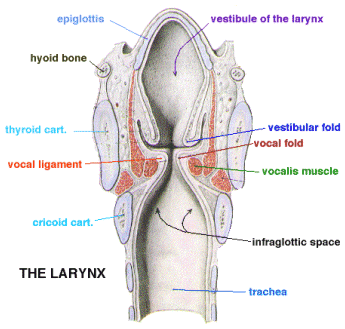Voice & Swallowing - Anatomy
The Larynx, Voice & Swallowing: Basic Anatomy and Physiology
A basic understanding of the what the larynx (vocal cords) and of voice production happens is necessary before a problem with your voice can be defined. This page is intended to give you a general idea of how your voice works, what the vocal cords look like, and a general description of the process involved in making sounds with your voice.
The larynx is positioned in the front of the neck and serves to separate the respiratory (breathing) and digestive (swallowing) tracts. Because of its location, the larynx plays a critical role in normal breathing, swallowing, and speaking. Damage to the larynx or its tissues can result in problems with any or all of these functions.
The larynx is made up mainly of two cartilages, the upper thyroid cartilage (whose front side is often felt as the "Adam's apple"), and the lower and smaller cricoid cartilage. The epiglottis lies on the top portion of this structure and protects the larynx during swallowing and prevents aspiration (breathing in) of food.

The vocal folds lie in the center of this structure in a front to back alignment. When viewed from above the vocal folds appear as a "V"-shaped structure with the opening between the "V" being the entrance to the trachea (wind pipe, air tube). At the rear of the larynx on each side, each vocal fold is attached to a small arytenoid cartilage. Many small muscles also attach to the arytenoids. These muscles contract or relax during the various stages of breathing, swallowing, and speaking, and their action is vital to the normal function of the larynx.
Control over these muscles is provided by two branches of the vagus nerve: the recurrent laryngeal nerve and the superior laryngeal nerve. These nerves can be injured by trauma, surgery, or other causes. If this occurs, paralysis of the vocal folds may occur. This leads to the hoarseness, aspiration, and other symptoms associated with laryngeal nerve injury.
Voicing, or phonation, is a complicated process in which sound is produced for speech. During phonation, the vocal folds are brought together by muscles attached to the arytenoids (cartilages structure). As air is forced through the vocal folds, they vibrate and produce sound. By tightening or relaxing the laryngeal muscles, the sounds of your voice can be changed. As the sound produced by the larynx travels through the throat and mouth, it is further changed to produce speech.

How to Make an Appointment
Please contact our office regarding scheduling appointments. Prior to scheduling an appointment, our providers often need to review chart notes related to the reason you want to be seen in order to coordinate any additional tests they may need in order to make the most of your visit. In some cases, we will require a referral from your primary care physician. We would be happy to discuss this with you to ensure we have all we need to expedite the scheduling process. Please contact us by phone or email to begin the process.
Phone: NW Clinic for Voice & Swallowing 503-494-5947
Email: Otolaryngology - ENT Clinic
If you have a question for one of our providers, please email us